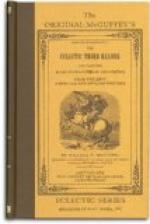Sound as in Sound as in oi oil ou out oy boy ow now
TABLE OF SUBVOCALS.
Sound as in Sound as in b bib v valve d did th this g gig z zin j jug z azure n nine r rare m maim w we ng hang y yet l lull
TABLE 0F ASPIRATES.
Sound as in Sound as in f fifi t tat h him sh she k kite ch chat p pipe th thick s same wh why
TABLE OF SUBSTITUTES.
Sub for as in Sub for as in a o what y i myth e a there c k can e a feint c a cite i e police ch sh chaise i e sir ch k chaos o u son g j gem o oo to n ng ink o oo wolf s z as o a fork s sh sure o u work x gz exact u oo full gh f laugh u oo rude ph f phlox y i fly qu k pique qu kw quit
PUNCTUATION.
Punctuation Marks are used to make the sense more clear.
A Period (.) is used at the end of a sentence, and after an abbreviation; as,
James was quite sick. Dr. Jones was called to see him.
An Interrogation Mark (?) is used at the end of a question; as,
Where is John going?
An Exclamation Mark (!) is used after words or sentences expressing some strong feeling; as,
Alas, my noble boy! that thou shouldst die!
The Comma (,), Semicolon (;), and Colon (:) are used to separate the parts of a sentence.
The Hyphen (-) is used to join the parts of a compound word; as, text-book: it is also used at the end of a line in print or script, when a word is divided; as in the word “sentence,” near the bottom of page 9.
[Illustration: Bird perched on tree branch.]
Lesson I.
news’paper cold or’der seem through
stock’ings chat sto’ry light Har’ry
branch’es kiss burns Mrs. e vents’
an oth’er Mr. stool lamp mends
[Illustration: Family at evening; father reading newspaper, mother sewing, boy and girl reading.]
Evening at home.
1. It is winter. The cold wind whistles through the branches of the trees.
2. Mr. Brown has done his day’s work, and his children, Harry and Kate, have come home from school. They learned their lessons well to-day, and both feel happy




